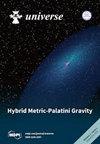Further Study of the Relationship between Transient Effects in Energetic Proton and Cosmic Ray Fluxes Induced by Coronal Mass Ejections
IF 2.5
4区 物理与天体物理
Q2 ASTRONOMY & ASTROPHYSICS
引用次数: 0
Abstract
The study and better understanding of energetic transient phenomena caused by disturbances occurring on our Sun are of great importance, primarily due to the potential negative effects those events can have on Earth’s environment. Here, we present the continuation of our previous work on understanding the connection between disturbances in the flux of energetic particles induced in the near-Earth environment by the passage of interplanetary coronal mass ejections and related Forbush decrease events. The relationship between the shape of fluence spectra of energetic protons measured by the instruments on the SOHO/ERNE probe at Lagrange point L1, Forbush decrease parameters measured by the worldwide network of neutron monitors, and coronal mass ejection parameters measured in situ is investigated. Various parameters used to characterize transient phenomena and their impact on the heliosphere, provided by the WIND spacecraft, were utilized to improve the accuracy of the calculation of the associated energetic proton fluence. The single and double power laws with exponential rollover were used to model the fluence spectra, and their effectiveness was compared. Correlation analysis between exponents used to characterize the shape of fluence spectra and Forbush decrease parameters is presented, and the results obtained by the two models are discussed.进一步研究日冕物质抛射诱发的高能质子和宇宙射线通量的瞬态效应之间的关系
研究和更好地理解由太阳上发生的扰动引起的高能瞬变现象非常重要,这主要是因为这些事件可能会对地球环境产生负面影响。在此,我们将继续之前的工作,了解行星际日冕物质抛射通过时在近地环境中诱发的高能粒子通量扰动与相关的福布什下降事件之间的联系。研究了在拉格朗日点 L1 的 SOHO/ERNE 探测器上的仪器测量到的高能质子通量频谱的形状、全球中子监测器网络测量到的福布什下降参数和原地测量到的日冕物质抛射参数之间的关系。利用 WIND 航天器提供的用于描述瞬变现象及其对日光层影响的各种参数,提高了相关高能质子通量计算的准确性。使用带有指数翻转的单幂律和双幂律来模拟通量谱,并比较了它们的有效性。对用于描述通量频谱形状的指数与福布什下降参数之间的相关性进行了分析,并讨论了这两种模型得出的结果。
本文章由计算机程序翻译,如有差异,请以英文原文为准。
求助全文
约1分钟内获得全文
求助全文
来源期刊

Universe
Physics and Astronomy-General Physics and Astronomy
CiteScore
4.30
自引率
17.20%
发文量
562
审稿时长
24.38 days
期刊介绍:
Universe (ISSN 2218-1997) is an international peer-reviewed open access journal focused on fundamental principles in physics. It publishes reviews, research papers, communications, conference reports and short notes. Our aim is to encourage scientists to publish their research results in as much detail as possible. There is no restriction on the length of the papers.
 求助内容:
求助内容: 应助结果提醒方式:
应助结果提醒方式:


